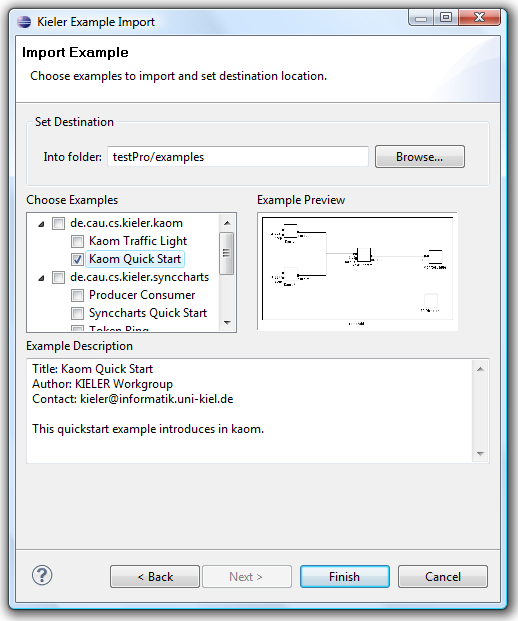Example Management (KEX)
Project Information
Responsible:
Related Theses:
- Paul Klose, Beispiel Management in KIELER, September 2010 (pdf)
KEX stands for KIELER Example Management. With this feature you are able to add so-called Examples to your KIELER workspace. This examples are typically models or templates of SyncCharts, KIELER Actor Oriented Modeling etc., but there is no restriction. On the other hand you are able to create new Examples with the KEX Export mechanism.
KEX Tour
KEX consists of an Import- and Export part. The Import mechanism allows KIELER users to import KIELER examples into their workspace. The Export mechanism allows KIELER users with KIELER writing permissions (usually the developers) to add examples to a pool of existing examples. However, the export is work in progress.
In the following you will see how to use the import feature.
Import
Open the filemenu of KIELER and click the tag Import.... Alternatively you can open the import dialog by opening the contextmenu of your navigator- or projectexplorer view and choosing Import.... Choose KIELER category in the opening import dialog. Select Example and click Next to open the import wizard. Depending on installed features of KIELER this could take a moment. What you see should look like the following picture.

First you have to set the import location, that has to be a project or a folder in your workspace. If you want to choose an example that creates an own project, no location has to be set. Afterwards one or more examples have to be choosen. The examples are sorted by categories. When selecting an example, a preview picture appears. With a click on that, a maximum representation of that pictures appears. After clicking the button clicking Finish, you should see your new example in an editor saved in the selected location.
Behind the Curtain
An example created with KEX contains some attributes such as an id and title. Furthermore it contains a sequence of resources and categories. A category represents a container for examples. The number after the attribute is 1 if this attribute is required and 0 if it is optional.
A category consists of the following:
- id, 1: unique identifier
- title, 1: representation of that category
- description, 0: short description of the category
- icon, 0: an icon
- parent_category, 0: a category can be a subcategory, then there have to exist a parent_category
A resource in the sense of KEX depends on the KEX backend.
- local_path, 1: the path inside of the plugin
- resource_type: File, Folder, Project
An example consists the following:
- id, 1: unique identifier, generally created by concatenation of category and title.
- title, 1: representation of that example.
- description, 1: explain what is meant with that example.
- category, 1: one of the created categories.
- author, 1: creator of example.
- resource, 1: a sequence(1,n) of resources.
- contact, 0: a emailaddress or a url to homepage for support or bugs.
- overview_pic, 0: gives an overview over that example, for example a emf diagram.
Currently only plugin/extensionpoint mechanismn is supported as backend and needs following extensions:
resource:
- direct_open, 1: boolean that manages if the resource should be loaded in an editor or not.
example:
- root_directory, 1: directory in an plugin that is root for examples.